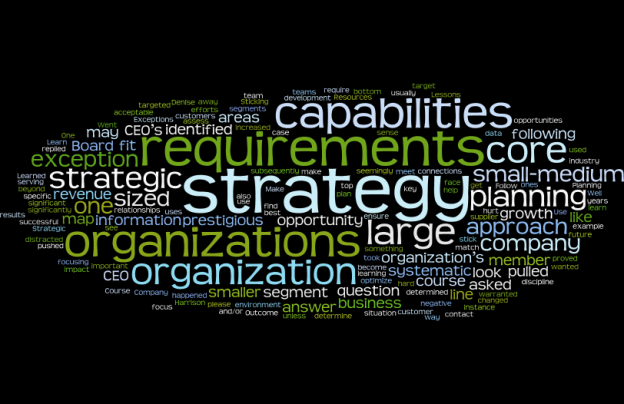By Denise Harrison
Many senior executives struggle to define a consistent approach to strategic planning. How does it all fit together? What information is necessary? How do we prevent the process from becoming analysis/paralysis?
Executives want a consistent process that:
- Looks systematically at external factors that influence the organization
- Evaluates internal strengths, weaknesses and competitive differentiators
- Evaluates opportunities consistently
- Allows for decisions to be made based on information and research. rather than “top of mind thinking”
- Allows the team to make and agree on decisions on where the company’s resources should be focused (i.e., Focus on the few.)
- Results in action plans that achieve the company’s strategic initiatives
- Develops a monitoring schedule to stay on track and make course corrections when business conditions change
There are many books on strategic planning, but few address the structure of the strategic planning process itself. After years of experience working with many clients, we found the following approach achieves the best results: three session focusing on:
- Situation Analysis
- Strategy Formulation
- Implementation
Situation Analysis
Start by agreeing on where the organization is today and identifying what research is required to make good decisions in the strategy formulation meeting. This includes:
- Current situation: What are we good at? (strengths) What are we not so good at? (weaknesses) What differentiates us from the competition? (competencies)
- Research: Typically includes research on: Core businesses, new opportunities and other external factors, such as: competition, technology, trends and regulations.
During the meeting, you select topics in each of these areas to be researched before the next meeting. Research typically takes four to eight weeks.
Strategy Formation
During this meeting, you will make decisions on where to focus your resources to achieve the best results. In strategic planning the easy part is saying “yes”; the hard part is saying “no” to good ideas, but ones that are not as good as the ones selected. You will start the session reviewing the research so that the team has a shared base of knowledge with which to make good judgments. With this shared base of knowledge, you then define what the leading company will look like in the future. With this long-term vision in mind, you will start making decisions on what core businesses should receive the most emphasis and what opportunities to pursue. You will discuss strategic issues that come up (e.g., should we exit this business?) and assess the threats facing the organization. Once you have covered the above, you will summarize your decisions in a strategy documents that covers:
- What you are going to do in each of your core businesses
- What new opportunities you are going to pursue.
- What you need to do internally to get where you want to go.
Once the summary strategy document is developed, the team will select 6-10 strategic initiatives to accomplish in the 12-18 months. The assignment for the next meeting is to develop action plans to accomplish each of these strategic initiatives. Each action plan will have clear action steps including who is responsible, how much it will cost and how much time it will take. With these plans, a preliminary budget is developed.
Implementation
During this meeting the action plans are reviewed to answer such questions as: If we complete this action plan will we achieve the objective? Do we have enough resources (human and financial) to complete all the initiatives on our plate? Finally, you set the monitoring schedule to ensure that the team stays on track with its initiatives and allows for course corrections when business conditions change.
Structure
While many balk at the formal structure, that we use, this strategic planning structure allows for decisions to be based on information and research rather than top of mind thinking. It develops a shared base of knowledge within in the team and allows for the development of a well thought out strategy with tactical plans the ensure execution. The team will support the strategy since they will have developed the data used to make the decisions on where to focus the team’s efforts.
If you have questions about the structure or would like to know how you can tailor the structure to meet your firm’s specific requirements, please contact me at: harrison@thestratplan.com or 910-763-5194.
© Copyright 2017 by Spex, Inc., Wilmington, NC — Reprint permission granted with full attribution.

